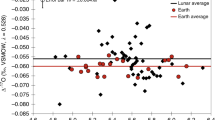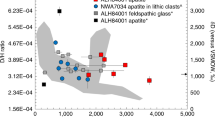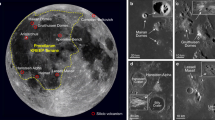Abstract
The Moon's bulk composition is a major constraint on its origin and evolution. Bulk density alone shows that the Moon is depleted in metallic FeNi relative to the Earth or to chondrites with earthlike MgO/FeO ratios (such as H-group chondrites). Depletions of minor-trace volatile elements are also obvious from geochemical data. The simplest assumption would be that the Moon is not much different in terms of nonsiderophile, nonvolatile elements from the silicate portions of the Earth or H chondrites. Lunar heat flow data1 have been interpreted to imply that the Moon's uranium content is about 46 ng g−1, about twice that of the Earth's mantle, and three times that of H-chondrite silicates. As it is difficult to envisage any process preceding the formation of planets that would fractionate refractory lithophiles such as uranium from major lithophiles such as Si, disparity in the U/Si ratio implies disparity in provenance or origin. Based on a new model that takes into account the considerable, but variable, thickness of porous, low-conductivity megaregolith, the thickness of the lunar lithosphere, and the nonrepresentative composition of the crust at one of the two sites where heat flow was measured, we estimate here that the Moon's uranium content is roughly 19 ng g−1. The Moon's bulk composition appears far less exotic than generally assumed.
This is a preview of subscription content, access via your institution
Access options
Subscribe to this journal
Receive 51 print issues and online access
$199.00 per year
only $3.90 per issue
Buy this article
- Purchase on Springer Link
- Instant access to full article PDF
Prices may be subject to local taxes which are calculated during checkout
Similar content being viewed by others
References
Langseth, M. G., Jr., Keihm, S. J. & Peters, K. Proc. 7th Lunar Sci. Conf. 3143–3171 (1976).
Warren, P. H. in Workshop on Pristine Highlands Rocks and the Early History of the Moon (eds Longhi, J. & Ryder, G.)(Lunar and Planetary Institute Technical Rep. 83-02, 75-79, 1983); Geochim. cosmochim. Acta 47, 1559–1571 (1983).
Taylor, S. R. Planetary Science: A Lunar Perspective (Lunar and Planetary Institute, Houston, 1982).
Morgan, J. W., Hertogen, J. & Anders, E. Moon and Planets 18, 465–478 (1978).
Keihm, S. J. & Langseth, M. G. Proc. 8th Lunar Sci. Conf. 499–514 (1977).
Conel, J. E. & Morton, J. B. The Moon 14, 263–289 (1975).
Schubert, G., Stevenson, D. & Cassen, P. J. geophys. Res. 85, 2531–2538 (1980).
Aggarwal, H. R. & Oberbeck, V. R. Proc. 10th Lunar planet. Sci. Conf. 2689–2705 (1979).
Golombeck, M. P. J. geophys. Res. 84, 4657–4666 (1979).
Thompson, T. W. et al. Moon Planets 21, 319–342 (1979).
Head, J. W. Proc. 7th Lunar Sci. Conf. 2913–2929 (1976).
Horz, F. Proc. 9th Lunar planet. Sci. Conf. 3311–3331 (1978).
DeHon, R. A. & Waskom, J. D. Proc. 7th Lunar Sci. Conf. 2729–2746 (1976).
Peeples, W. J. et al. J. geophys. Res. 83, 3459–3468 (1978).
Head, J. W. & Settle, M. Imbrium Consortium Vol. 1 (ed. Wood, J. A.) 5–14 (Smithsonian Astrophysics Observatory, Massachusetts, 1976).
DeHon, R. A. Proc. 10th Lunar planet. Sci. Conf. 2935–2955 (1979).
Talwani, M., Thompson, G., Dent, B., Kahle, H.-G. & Buck, S. Apollo 17 Preliminary Science Rep. (ed. Parker, R.A.) 13.1–13.13 (NASA, Washington, 1973).
Horai, K. & Winkler, J. L. Jr Proc. 7th Lunar Sci. Conf. 3183–3204 (1976).
Apollo Lunar Sample Information Catalogs (Lunar Sample Curator, NASA Johnson Space Center, Houston).
Horai, K. J. geophys. Res. 76, 1278–1308 (1971).
Hood, L. L., Herbert, F. & Sonett, C. P. J. geophys. Res. 87, A109–A116 (1982).
Ringwood, A. E. Origin of the Earth and Moon (Springer, New York, 1979).
Metzger, A. E., Haines, E. L., Parker, R. E. & Radocinski, R. G. Proc. 8th Lunar Sci. Conf. 949–999 (1977).
Surkov, Yu. A. Proc. 12th Lunar planet. Sci. Conf. 1377–1386 (1981).
Warren, P. H. & Wasson, J. T. Rev. Geophys. Space Phys. 17, 73–88 (1979).
Binder, A. B. The Moon 14, 237–245 (1975).
Bills, B. G. & Ferarri, A. J. J. geophys. Res. 82, 1306–1314 (1977).
Warren, P. H. et al. J. geophys. Res. 88, B151–B164 (1983).
Wanke, H. et al. Proc. 5th Lunar Sci. Conf. 1307–1335 (1974).
Anderson, D. L. Earth planet. Sci. Lett. 18, 301–316 (1973).
Mason, B US geol. Surv. Prof. Pap. 440 -B, Part 1 (1979).
Author information
Authors and Affiliations
Rights and permissions
About this article
Cite this article
Rasmussen, K., Warren, P. Megaregolith thickness, heat flow, and the bulk composition of the Moon. Nature 313, 121–124 (1985). https://doi.org/10.1038/313121a0
Received:
Accepted:
Issue Date:
DOI: https://doi.org/10.1038/313121a0
This article is cited by
-
Potential Effects of Surface Temperature Variations and Disturbances and Thermal Convection on the Mars InSight HP3 Heat-Flow Determination
Space Science Reviews (2017)
-
Lunar-A mission: Outline and current status
Journal of Earth System Science (2005)
Comments
By submitting a comment you agree to abide by our Terms and Community Guidelines. If you find something abusive or that does not comply with our terms or guidelines please flag it as inappropriate.



